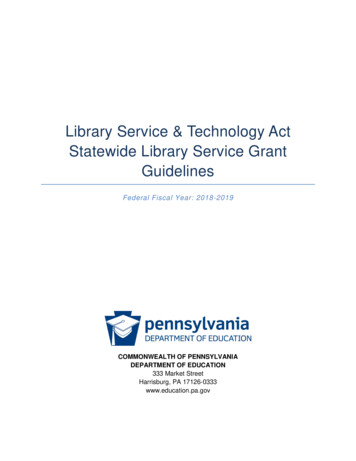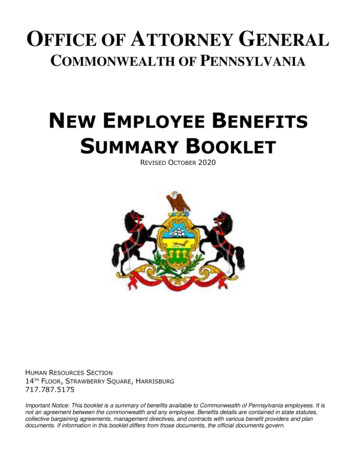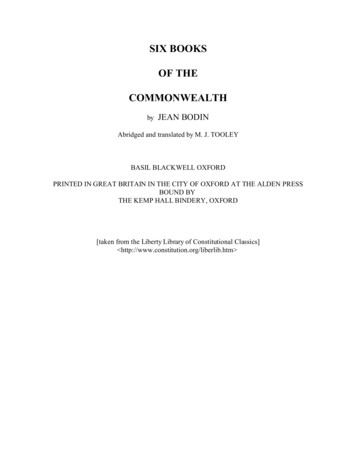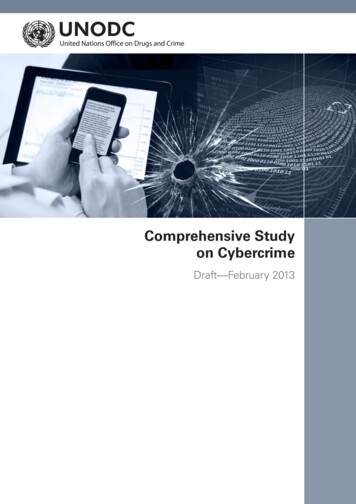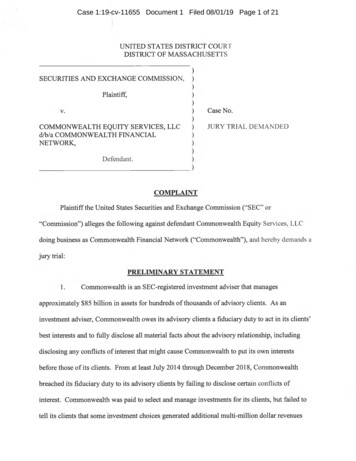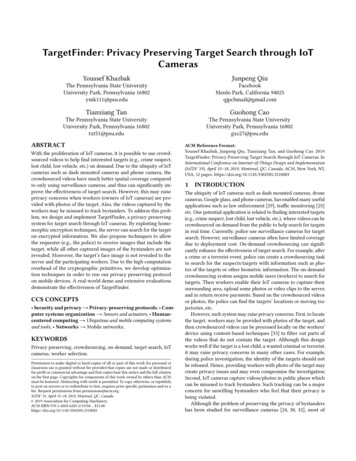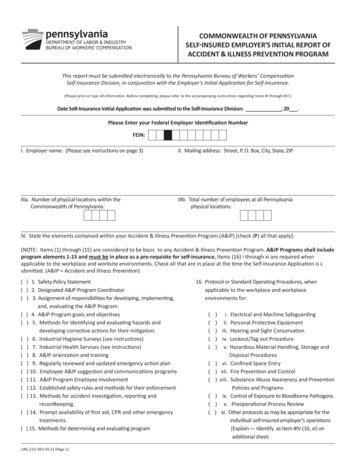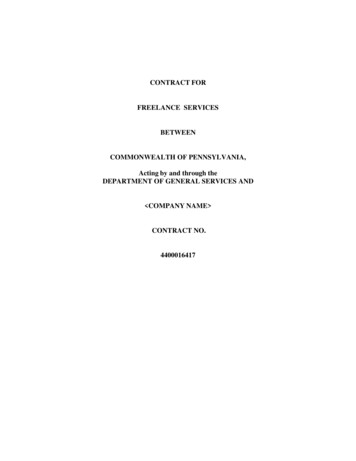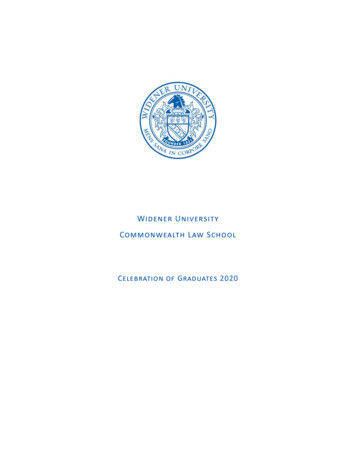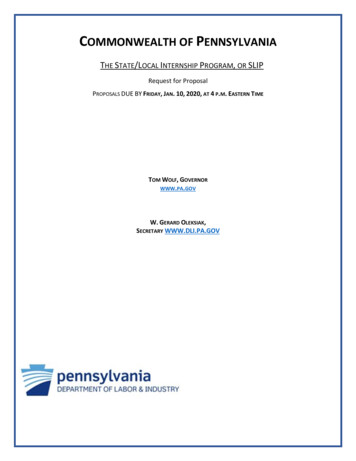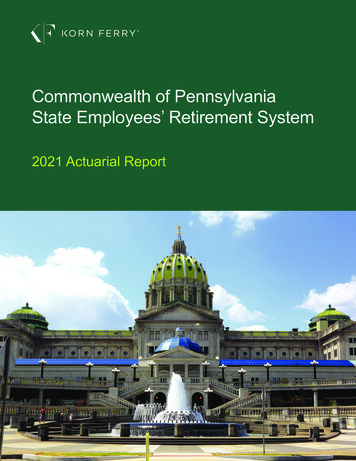
Transcription
Commonwealth of PennsylvaniaState Employees’ Retirement System2021 Actuarial Report
COMMONWEALTH OF PENNSYLVANIASTATE EMPLOYEES’ RETIREMENT SYSTEM2021 ACTUARIAL REPORTDEFINED BENEFIT PLANKORN FERRYJUNE 10, 2022
11911 FREEDOM DRIVE, SUITE 790RESTON, VA 20190 1.703.841.3100 www.kornferry.comJune 10, 2022Mr. Joseph A. TortaExecutive DirectorState Employees' Retirement System30 North Third Street - Suite 150Harrisburg, PA 17101-1716Dear Mr. Torta:The purpose of this letter and the enclosed report is to certify the actuarial adequacy of thecontributions being made by the Commonwealth of Pennsylvania and other participating agenciesto the Pennsylvania State Employees’ Retirement System (SERS), and to discuss the approachcurrently being taken toward meeting the financing objectives of the plan. Use of this letter andthe enclosed for purposes other than stated may not be appropriate. The results provided hereinare based upon the December 31, 2021 annual actuarial valuation.The funding objective of the plan is set forth in the State Employees’ Retirement Code (SERC).The annual employer contribution is equal to the sum of the following for the commonwealthfiscal year beginning July 1, 2022:(1)(2)The employer share of the normal cost.The fresh start amortization of the December 31, 2009 unfunded liability over a 30year period beginning July 1, 2010 and ending on June 30, 2040.(3) The amortization of the change in liability due to Act 2010-120 (Act 120) over a 30year period beginning July 1, 2011 and ending on June 30, 2041.(4) The amortization of changes in liability due to actual experience differing fromassumed experience after December 31, 2009 over 30-year periods beginning withthe July following the actuarial funding valuation determining such changes.(5) The extra contribution to return Act 2017-5 savings.(6) The amortization of legislated benefit changes, including cost-of-living increases,over 10-year periods beginning with the July following the actuarial valuationdetermining such changes. (Note: There are currently no 10-year amortizationsbeing funded.)The amortization payments are level dollar amounts over the remaining applicable amortizationperiods. The employer cost is determined as a percent of retirement covered compensation. Thetotal employer cost is the average contribution amount that needs to be received from theemployer groups participating in the system. Some employer groups contribute a higher percentof compensation and others contribute a lower percent of compensation, depending on thebenefits payable to each group’s employees.
Mr. Joseph A. TortaJune 10, 2022The actuarial valuation is based on financial and participant data, which is supplied by SERSstaff. We rely on that data and review it for consistency and reasonableness prior to using it inthe valuation. The accuracy of the valuation results is dependent on the accuracy of the suppliedinformation.The actuarial valuation uses various economic and demographic assumptions regarding futureplan experience. These assumptions were adopted by the State Employees’ Retirement Board(the Board) in July of 2020 based upon the recommendations included in our July 2020 report onthe nineteenth investigation of actuarial experience of SERS, covering the years 2015 through2019. These changes to both the economic and demographic assumptions were implementedwith the December 31, 2020 actuarial valuation. To ensure that the investment return assumptionremains up-to-date and appropriate for every actuarial valuation, it is reviewed annually by theSERS actuaries and Board. The Board maintained the annual investment return assumption at7.00% and the inflation assumption at 2.50% during its 2021 review. We will continue to closelymonitor the investment return assumption and will recommend changing it if conditions warrantsuch change.Apart from the statutory funding requirements set forth in the SERC, there are also separateaccounting standards to which SERS is subject for financial reporting purposes. GovernmentalAccounting Standards Board (GASB) Statement No. 67, Financial Reporting for Pension Plans,replaced the requirements of GASB Statement No. 25, Financial Reporting for Defined BenefitPension Plans and Note Disclosures for Defined Contribution Plans, effective for financialstatements for the fiscal year ended June 30, 2014. GASB Statement No. 68, Accounting andFinancial Reporting for Pensions, which establishes standards for accounting and financialreporting by state and local governments for pensions, replaced the requirements of GASBStatement No. 27, Accounting for Pensions by State and Local Governmental Employers,effective for the fiscal year ended June 30, 2015. The actuarial information required underStatements No. 67 and 68 is not included in this report. These results were provided separatelyto SERS for inclusion in their annual financial reporting to the public and to the participatingemployers of the system.Based upon the valuation results, it is our opinion that, provided future employer contributionsare made in accordance with current law, the Pennsylvania State Employees' Retirement Systemis, and will continue to be, adequately funded, in accordance with generally accepted actuarialprinciples and procedures.2
Mr. Joseph A. TortaJune 10, 2022It should be noted that, during June of 2017, Governor Tom Wolf signed into law Act 2017-5.Act 2017-5 fundamentally changed retirement options for most new hires beginning January 1,2019. This legislation introduced two new hybrid defined benefit (DB)/defined contribution (DC)options and a straight DC option. New classes of service now apply to most State employees whofirst become SERS members on or after January 1, 2019; however, most hazardous dutyemployees are exempt from the new plan design.In April 2020, SERS received an advance payment of 1,061 million from the Pennsylvania StateUniversity (PSU), and in April 2021, SERS received an advance payment of 825 million fromthe Pennsylvania State System of Higher Education (PASSHE). The advance payments werepart of a funding agreement under Act 2019-105 that reduced PSU’s and PASSHE’s allocatedshares of the unfunded liability and created schedules of setoff amounts that reduce the futurecontributions due from each. These arrangements accelerated the funding of SERS but are notexpected to increase the long-term funded status of SERS since the future contributions from PSUand PASSHE will be reduced by the value of the advance payments.To ensure the expected benefit of the advance payments is allocated to PSU and PASSHE, thevalue of the future setoff amounts is added to the unfunded liability to determine the AmortizationLiability. The Amortization Liability is used to determine the amortization payments due fromall employers, prior to recognizing any setoff amounts. This allows the effect of the advancepayments to be allocated only to PSU and PASSHE and have no expected effect on thecontributions due from the other employers.Please note that future actuarial measurements can differ significantly from current measurementsdue to such factors as plan experience differing from that anticipated by the assumptions, changesin future assumptions, and changes in plan provisions or applicable law. It is beyond the scopeof our annual actuarial valuation to perform an analysis of the potential range of such futuredifferences in measurement; however, we have performed such an analysis and presented theresults in a separate Stress Testing and Risk Assessment report, dated September 28, 2021, whichis available on the SERS website.Actuarial CertificationTo the best of our knowledge, this report is complete and accurate and all costs and liabilitieshave been determined on the basis of actuarial assumptions and methods which are reasonable(taking into account the past experience of SERS and reasonable expectations) and whichrepresent our best estimate of anticipated experience under the plan. The report, costs, liabilities,assumptions, and methods used for funding purposes are in accordance with the parameters setby Actuarial Standards of Practice.3
Mr. Joseph A. TortaJune 10, 2022The actuaries certifying to this valuation are members of the Society of Actuaries or otherprofessional actuarial organizations and meet the Qualification Standards of the AmericanAcademy of Actuaries for purposes of issuing Statements of Actuarial Opinion.Respectfully submitted,Korn FerryByCraig R. GrabyMember American Academy of ActuariesEnrolled Actuary No. 20-73194ByKristopher E. Seets, F.S.A.Member American Academy of ActuariesEnrolled Actuary No. 20-8055
Table of ContentsSchedulePageValuation Highlights.-1Comments on Schedules .-9Unfunded Liability and Normal Cost .A16Employer Contribution Rate .B17Employer Contribution Rate by Group .C18Development of Shared-Risk/Gain Member Contributions.D19Analysis of Change in Employer Contribution Rateand Amortization Liability .E21Actuarial Balance Sheet .F22Required Transfers Within SERS Accounts .G23Accounting Disclosure Statements .H24Solvency Test .I29Actuarial Value of Assets .J30Projection of Population, Benefits, and Contributions .K31Risk Measurements .L34Profile of Plan Participants .M39Summary of Benefit and Contribution Provisions .N49Actuarial Assumptions .O58Actuarial Methods .P66Advance Payments of Unfunded Liability Contributionsby SERS Employers .Q72Glossary .R76i
State Employees' Retirement SystemValuation HighlightsDecember 31, 2021ValuationDecember 31, 2020ValuationSummary of Employer Contributions as a Percent of Total CompensationSERS Plan ContributionNormal Cost8.32%1.50%Amortization of Liabilities25.78%31.64%Extra Contribution to Return Act 5 Savings0.00%0.62%Total SERS Plan Contribution34.10%33.76%Benefits Completion Plan ContributionTotal Contribution0.06%0.05%34.16%33.81%Demographic Characteristics of the PopulationActive Participants:NumberAverage ageAverage serviceAverage annualized covered compensationTotal annualized covered compensationFunding payrollAnnuitants and Beneficiaries:NumberAverage ageTotal annual pension 97,85746.611.365,2346,383,604,0006,649,292,000 134,36070.43,293,490,627Inactive and Vested Participants:Number 100,96246.511.363,8026,441,578,0006,700,320,000 133,33470.13,190,590,4897,2376,856AssetsMarket Value of AssetsActuarial Value of Assets Funded Status (Market Assets)Funded Status (Actuarial Assets)40,225,058,37736,846,610,59576.0%69.6% 35,022,663,92132,703,275,23063.6%59.4%Note: The terms "employee," "member" and "participant" are used interchangeablythroughout this report; however, there are distinct differences between them. In general, an"employee" is an individual who is actively employed by the Commonwealth, a "member" isan employee who is covered by the SERS defined benefit (DB) plan and a "participant" is anemployee who is covered by the SERS defined contribution (DC) plan.1
State Employees' Retirement SystemEmployer Contribution Rate by GroupFiscal Year 2022 - 2023SERS 37%Class A-3 and A-4 Members:Age 65 RetirementAge 55 RetirementPark RangersCapitol PoliceState s AA Members:Age 60 RetirementAge 50 RetirementPark RangersCapitol PoliceEnforcement ass A Members:Age 60 RetirementAge 50 RetirementPark RangersCapitol PoliceState PoliceEnforcement 4%32.76%32.76%56.59%34.34%Class D-4 Legislators47.50%0.06%47.56%0.00%47.56%Class E Members50.69%0.06%50.75%0.00%50.75%Class A-5 Members:Class A-6 Members:DC Plan Only Members:*Includes 0.00% extra contribution to return Act 5 savings for all groups.The above group rates result in employer contribution rates (expressed as a percentage of total projectedcovered compensation for active members in fiscal year 2022-2023) of 34.10% for the SERS DB Plan, 0.06%for the Benefits Completion Plan and 34.16% in Total for the DB Plan. The above group rates are appliedto all employers prior to any setoff amounts related to an advance payment. The contributions due fromPSU will reflect a setoff amount of 93.3 million related to the 2020 advance payment and the contributionsdue from PASSHE will reflect a setoff amount of 79.9 million related to their 2021 advance payment.2
State Employees' Retirement SystemGeneral DiscussionThe liabilities and costs in this report are based upon actuarial assumptions adopted by the StateEmployees' Retirement Board (the Board) and funding procedures specified in the State Employees’Retirement Code (SERC). The SERC requires that the Board conduct a study of the actuarialexperience of SERS every five years as a basis for setting the actuarial assumptions used in thevaluation. A five-year study was conducted and delivered to the Board in July of 2020. The Boardapproved the recommendations of the actuary and the new assumptions were first used in theDecember 31, 2020 valuation.The most important actuarial assumptions are the investment return assumption, also known as thevaluation interest rate assumption, and the salary growth assumption. The investment returnexperience is reviewed annually and as a part of the normal five-year experience study cycle. As aresult of the review undertaken during July of 2020, the Board approved a reduction in the annualinvestment return assumption from 7.125% to 7.000%. The Board maintained the annual investmentreturn assumption at 7.00% during its 2021 review.Both the investment return and the salary growth assumptions are based upon an underlying inflationrate assumption of 2.50 percent per year. Salary growth is the total of assumed increases in salaryrates and career salary growth. It is generally assumed that the salary rates will increase by 2.8 percentper year due to general salary schedule increases and that career salary growth (promotion andlongevity growth) will average an additional 1.78 percent per year. Thus, the total average salaryincrease for an individual will generally be 4.58 percent per year.The employer contribution rate is determined as a percent of covered compensation that is the totalof (1) the employer normal cost percent and (2) the net amortization of the unfunded liability and (3)the extra contribution to return Act 5 savings, but not less than any applicable minimum contributionprescribed by the SERC. The final total employer contribution rate based on December 31, 2021 datais 34.10 percent of covered compensation, which is the sum of (1) the employer normal cost of 8.32percent of compensation plus (2) the net amortization of the unfunded liability of 25.78 percent ofcompensation plus (3) the extra contribution to return Act 5 savings of 0.00 percent. See Schedule Pfor further discussions of the Act 2010-120 minimum and the Act 2017-5 extra contributions to returnsavings.The funded ratio is the ratio of assets to the actuarial accrued liability. As a consequence of the globaleconomic downturn, SERS’ funded status, as measured by the funded ratio, declined significantlyduring 2008. A market return well above expectations in 2019 resulted in an increase in both themarket and actuarial value funded ratios from 52.0 percent to 58.7 percent, and from 56.0 percent to56.5 percent, respectively. In 2020, a second consecutive annual market return well aboveexpectations resulted in an increase in both the market and actuarial value funded ratios from 58.7percent to 63.6 percent, and from 56.5 percent to 59.4 percent, respectively. A market return wellabove expectations in 2021 resulted in an increase in both the market and actuarial value funded ratiosfrom 63.6 percent to 76.0 percent, and from 59.4 percent to 69.6 percent, respectively.3
State Employees' Retirement SystemChart 1 below presents a history of SERS funded ratios, relative to the 100% target funded status.SERS Historical Funded Status Assets / Actuarial Accrued Liability150%140%Funded Status130%120%110%100%90%80%70%60%50%Year (As of December 31)Funded Status (Actuarial Assets)Funded Status (Market Assets)Target Funded StatusDuring 2010, the count of pensioners exceeded the count of active participants for the first time in thehistory of SERS. As of December 31, 2021, the count of pensioners (134,360) further exceeds thecount of active participants (97,857), a clear sign of a mature retirement system. Chart 2 belowillustrates the maturing of the SERS population since 2001.Although it was noted previously that the interest rate and salary growth are the most importantactuarial assumptions, the maturity of the SERS population heightens the importance of the mortalityassumptions. Thus, the updates to the post-retirement mortality assumptions recommended by theactuary every five years based upon SERS’ actual ongoing mortality experience, have becomeincreasingly critical to the annual valuation process.4
State Employees' Retirement SystemSERS ParticipationPensioner Count First Exceeded Active Count in 2010Number of Participants (in thousands)140120100806040200Year (As of December 31)Active ParticipantsAnnuitants and BeneficiariesA separate and distinct Benefits Completion Plan provides benefits to certain members whose SERSbenefits are limited by IRC Section 415(b) maximum benefit limitations. The Benefits CompletionPlan employer contribution requirements for fiscal year 2022-2023, which were determined by aseparate December 31, 2021 actuarial valuation, are presented in the Valuation Highlights herein.Otherwise, Benefits Completion Plan costs and liabilities are not included in the schedules of thisreport.5
State Employees' Retirement SystemHistory of the Employer Contribution RateChart 3 below shows the history of the employer contribution rate from 1983 through 2021. Withsome fluctuations, the general trend from 1984 through 2001 had been downward, with the ratedeclining from the 18 percent range in the years 1983 and 1984 to zero in 2000 and 2001. Theinvestment returns were below the actuarial assumption (then 8.5 percent) in 2000 through 2002. Thechanges to the amortizations under Act 2003-40 and subsequent investment gains would have keptthe contributions from increasing, if it had not been for legislated floors that caused the employercontributions to increase between 2002 and 2005.From 2006 through 2015, actual employer contribution rates were at levels prescribed by law,increasing each year since 2009. Effective with the December 31, 2016 valuation, for the first timesince 2010, the employer contribution rate was uncollared (that is, no longer limited by the Act 2010120 rate collars). Note that the current valuation employer contribution rate shown below (34.10percent as of December 31, 2021) represents a small increase versus the prior valuation contributionrate (33.76 percent as of December 31, 2020).SERS Historical Employer Contribution Rates40%Percent of Payroll35%30%25%20%15%10%5%0%Valuation Date ( December 31 of Year Shown)Employer Contribution RatesEmployer Normal Cost RatesThe total employer cost is the actual contribution rate during the succeeding fiscal year. Forinstance, the rate of 34.10 percent of covered compensation for the December 31, 2021 valuationdate will be the employer contribution rate for the fiscal year beginning July 1, 2022.6
State Employees' Retirement SystemHistory of Inflation, Investment Return and Salary GrowthTable 1 below shows the rate of inflation, the nominal and real investment return based on the marketvalue of assets, and the nominal and real salary growth for the past twenty years. The nominal ratesare the actual investment rate and salary growth. The real rates are the nominal rates adjusted byremoving inflation. The inflation rates shown are based on the Consumer Price Index for All UrbanConsumers (CPI-U) data. The nominal rate of salary growth is the percentage increase in general paylevels specified by the predominant collective bargaining agreement. This salary growth includesgeneral pay increases, but excludes career salary growth (that is, pay changes resulting frompromotions or longevity growth).Table 1: Comparison of Annual Rates of GrowthInvestment ReturnSalary .2%3.2%0.9%The averages represent the geometric averages of all of the rates over the 20-year period, not thearithmetic averages.7
State Employees' Retirement SystemChart 4 below presents a 25-year history of SERS annual investment returns relative to theactuarially assumed returns of: 8.5% initially adopted for calendar year 1996 and retained through 2008,8.0% for 2009 through 2011,7.5% for 2012 through 2016,7.25% for calendar year 2017 through 2019,7.125% for calendar year 2020, and7.0% for calendar year 2021 and 202230%SERS Historical Annual Investment Returns20%10%0%-10%-20%-30%Actual Return on Assets8Assumed Return on Assets
State Employees' Retirement SystemComments on SchedulesEmployer Contribution RateSchedules A and B summarize the development of the employer contribution rate before allocationby group. The employer contribution is equal to the sum of (1) the employer share of the normalcost and (2) amortization of the unfunded liability and (3) the extra contribution to return Act 5savings.The normal cost is the level percentage of compensation needed to fund the liability for anyprospective benefits earned by all active members over the period of their actual service. Prior tothe 2021 valuation, the normal cost calculation used only active members in Classes A-5 and A-6who had not yet completed one year of credited service. The employer share of the normal costincreased from 1.50 percent in 2020 to 8.32 percent in 2021 primarily as a result of the change tothe funding method in which the normal cost calculation used all active members.Portions of the unfunded liability are amortized over either 10 years or 30 years, as required by theSERC. Under Act 2010-120, the total December 31, 2009 unfunded liability was amortized over30 years as part of a fresh start that combined all of the unfunded liability amortizations into oneamortization. Net losses in 2010 and after were amortized over 30 years. The total unfunded liabilityas of December 31, 2021 was 16.08 billion. As of December 31, 2020, the total unfunded liabilitywas 22.40 billion.In order to properly reflect the prefunding contribution made by the Pennsylvania State University(PSU) and the Pennsylvania State System of Higher Education (PASSHE), the valuation uses anamortization liability which nets out the present value of the future setoff amounts that will becredited to PSU and PASSHE. The amortization liability is now the basis for determining newamortization amounts and is 17.95 billion as of December 31, 2021. Additional informationrelating to the prefunding contribution is included in Schedule Q.Schedule B shows the allocation of the total amortization liability by year into those liabilitiesbeing amortized over 30 years. All amortization payments are level dollar amounts over theapplicable amortization period. There are currently no 10-year amortizations. The total net chargefor the amortization of the amortization liability is 25.78 percent of the total projected coveredcompensation for the 2022-2023 fiscal year.The employer contribution rate is equal to the total of the normal cost and the amortization of theamortization liability and the extra contribution to return Act 5 savings, but not less than the normalcost. The employer contribution rate calculated at 34.10 percent of covered compensation will beapplied for the fiscal year beginning July 1, 2022.Employer Contribution Rates by GroupSchedule C summarizes the development of the employer contribution rate for each group ofmembers with different benefits. The Normal Cost Rate for each group is valued based on the activemembers of the group. Three adjustments are made to the Normal Cost to develop the employergroup rates. The first is to add the Basic Contribution Rate, which funds annual payment of theAmortization Liability. The second is to multiply by the Basic Contribution Rate by the applicableadjustment factor relative to the Class A-5 and A-6 benefit values. Third, the Park Rangers, Capitol9
State Employees' Retirement SystemPolice and State Police Officers are also charged the amount necessary to fund the past service costof benefit improvements that were effective in prior years. These charges are further explained inSchedule P. The complete schedule of contributions by group is shown in Table 2.Table 2Employer Contribution Rate by GroupFiscal Year 2022/2023(Excluding Benefits Completion and DC PlanContributions)Class A5Age 67 Retirement16.12%Class A6Age 67 Retirement16.37DC Plan Only14.87Class A3/A4Age 65 RetirementAge 55 RetirementPark RangersCapitol PoliceState Police25.9929.2526.9926.9950.14Class AAAge 60 RetirementAge 50 RetirementPark RangersCapitol PoliceEnforcement Officers38.7643.4139.6739.6743.41Class AAge 60 RetirementAge 50 RetirementPark RangersCapitol PoliceState PoliceEnforcement Officers30.3834.2832.7032.7056.5334.28Class D-4 Legislators47.50Class E Members50.69Schedule D shows the development of the shared-risk/shared-gain member contributions, inaccordance with Act 2010-120. No shared-risk or shared-gain contribution applies for the 20222023 fiscal year.10
State Employees' Retirement SystemChange in Employer Contribution RateSchedule E contains an analysis of the change in the employer contribution rate and unfunded liabilityfrom the 2020 to the 2021 valuation.The largest decrease in the unfunded liability – 3,700.0 million – resulted from a change in thefunding method. Under the prior funding method, the Normal Cost Rate was determined using a newentrant group and now it is based on all active members. The decrease in unfunded liability cost of4.48 percent was offset by a 6.90 percent increase in the normal cost, for a net increase in cost of 2.42percent of compensation.Another decrease in the unfunded liability – 1,383.7 million – resulted from recognition (under thefive-year asset smoothing method) of four years of asset gains totaling 2,082.0 million, which morethan offset one year of asset losses equal to 698.3 million. This net gain of 1,383.7 million resultedin a 1.68 percent decrease in the total employer cost.Another decrease in the unfunded liability – 63.5 million – was due to smaller than expected payincreases and resulted in a decrease in the total employer cost of 0.08 percent of compensation.Another increase in the unfunded liability – 52.1 million – resulted from other differences betweenactual and expected experience of the covered population. This increase in liability resulted in anincrease in the total employer cost of 0.08 percent of compensation.Another increase in the unfunded liability – 51.6 million – resulted from changes in thedemographics of the new entrant population. The increase in unfunded liability cost of 0.06 percentwas offset by a 0.08 percent decrease in the normal cost, for a net decrease in cost of 0.02 percent ofcompensation. This is the final valuation where this change will be shown. Moving to a Normal CostRate that is based on all active members removes the need for this step in the future.Actuarial Balance Sheet and Account Balance TransfersSchedule F contains the actuarial balance sheet that compares the total assets and liabilities of 61.1billion. The assets include current assets and the present value of future contributions. The liabilitiesinclude the present value of all benefits to current active and retired members.Each year the account balances in the three benefit payment accounts are compared to the actuarialliabilities developed in the valuation. If needed, transfers are made to bring the accounts into
Commonwealth of Pennsylvania State Employees' Retirement System 2021 Actuarial Report. . Harrisburg, PA 17101-1716 . Dear Mr. Torta : . Academy of Actuaries for purposes of issuing Statements of Actuarial Opinion. Respectfully submitted, Korn Ferry .
